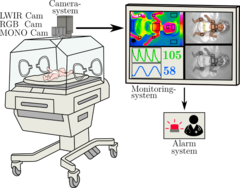Systemic Inflammatory Response Indication Observer
Contact Person
Project Description
Sepsis is one of the most frequent complications in premature and newborn infants in the intensive care unit and, due to the often-unspecific symptoms and simultaneous rapid progression, it represents a major threat in terms of mortality and long-term morbidity. To monitor neonatal patients, various vital parameters are recorded using contact-based measurement methods such as ECG and a PPG (photoplethysmography). The immature skin with the missing subcutis and the associated inefficient barrier to the environment of the neonate pose particular risks, as the skin can be additionally injured when changing the adhesive sensors. This can lead to infection-prone wounds that can result in life-threatening sepsis.
For the prognosis and the success of a therapy, it is precisely the early detection of an infection that is decisive. The diagnosis is not made based on a single parameter but must be determined by time-consuming and personnel-intensive examinations. The use of non-contact measurement technology for continuous monitoring of neonates is intended to reduce the workload of personnel and enable the earliest possible (patient-friendly) detection of infectious conditions.
The research project SIRIO is concerned with the implementation of a system for camera-based monitoring of vital parameters that can automatically detect the first signs of a septic shock. For this, monitoring of multiple vital signs is important, including heart and respiratory rates and their variability, spatially resolved perfusion, body temperature in different body regions, and physical activity.
These parameters could be captured by a smart fusion of multiple camera-based measurement techniques that can be used to determine an early warning parameter. These are wireless PPG (photoplethysmography imaging, or PPGI) using an RGB camera and infrared thermography. The two camera systems cover different spectral sensitivity ranges and perform different functions for measuring vital signs. While the PPGI allows the recording of heart rate and perfusion in the tissue and additionally a quantification of the microcirculation, the infrared thermography indicates the radiation of the patient's own body heat. This also allows local temperature distributions and central-peripheral gradients to be recorded and analyzed. Respiration can be captured via respiratory synchronous movements of the thorax from both camera modalities. In addition to an RGB camera, monochrome cameras can also be used for that.
The data fusion of both camera systems enables the derivation of an early warning parameter directly at the incubator in the intensive care unit. In the future, this could lead to an earlier start of therapy and thus significantly improve the neonates' chances of healing and survival.
Project Goals
- Implementation of a low-cost multimodal camera system
- Design of real-time capable algorithms for image processing and vital sign analysis on GPUs
- Derivation of a camera-based warning score for sepsis risk classification
Project Partner
Klinik für Kinder- und Jugendmedizin, Klinikum der RWTH Aachen




